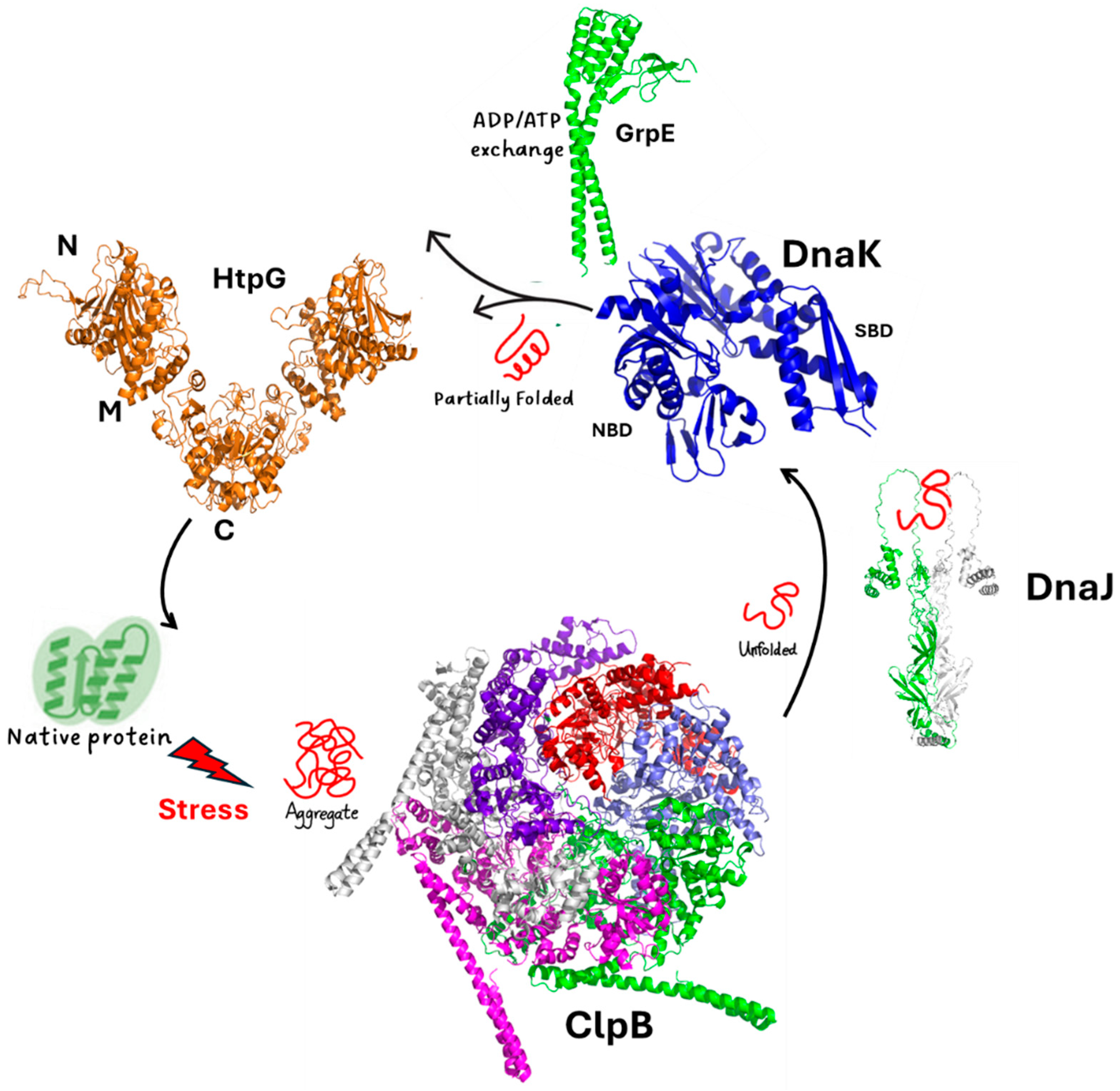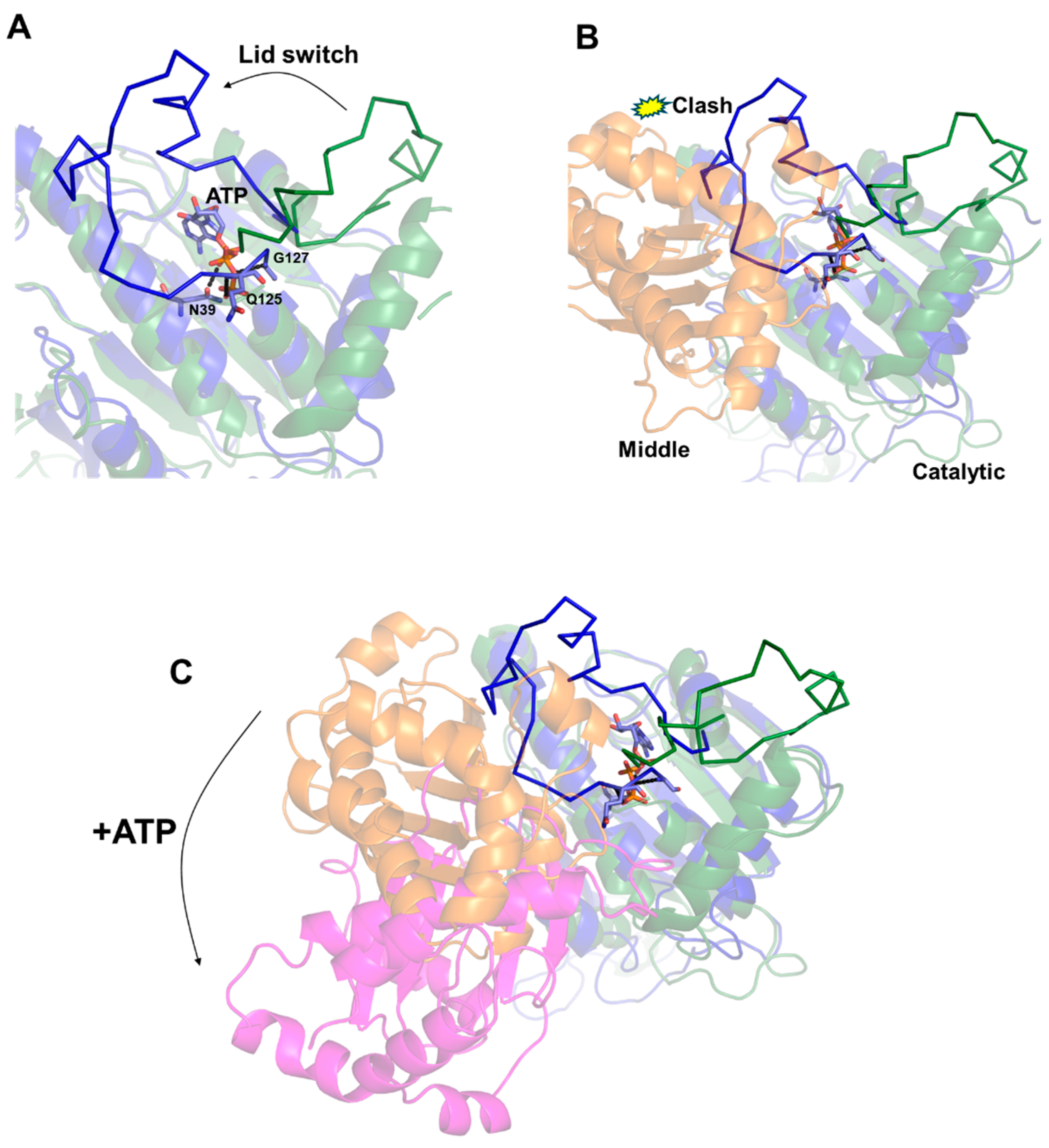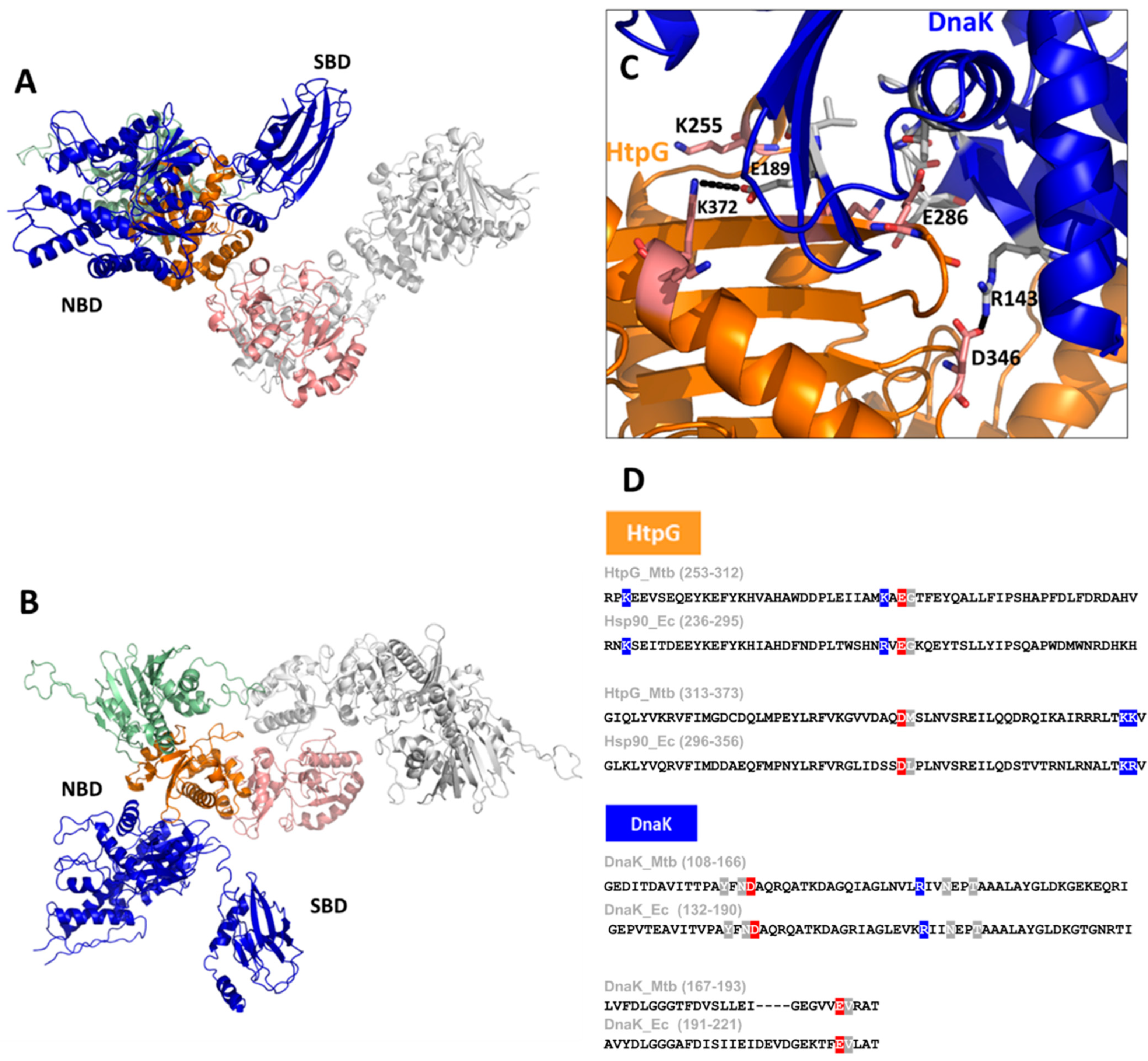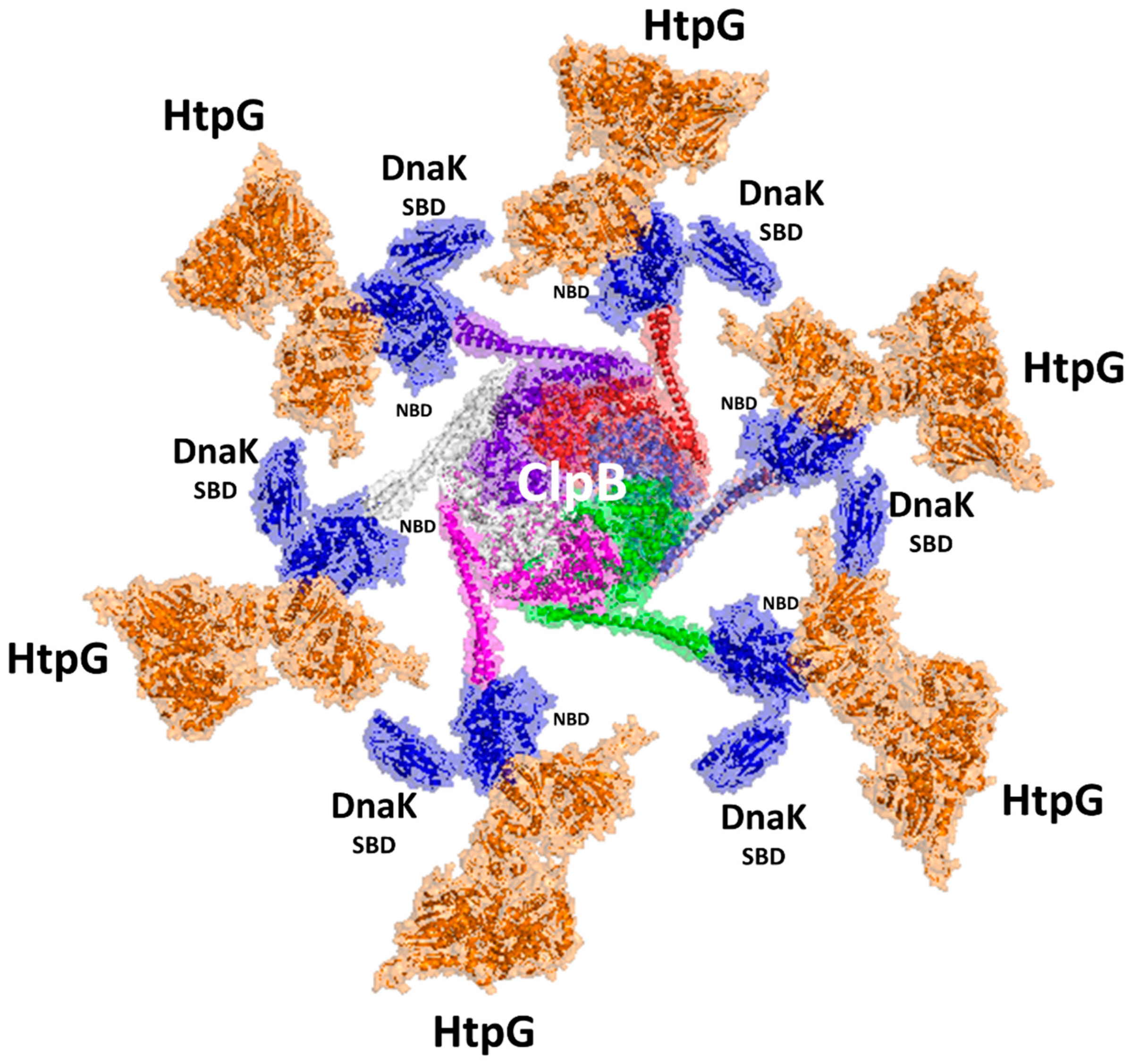HtpG—A Major Virulence Factor and a Promising Vaccine Antigen against Mycobacterium tuberculosis
Abstract
:1. Introduction
2. HtpG of M. tuberculosis, a Mycobacterial Virulence Factor
3. HtpG Belongs to a Well-Orchestrated Chaperone Network

4. A Structural Model of HtpG Interactions in the Chaperone Machinery of Mtb
5. HtpG as a Vaccine Antigen
6. Conclusions
Author Contributions
Funding
Conflicts of Interest
References
- Delogu, G.; Sali, M.; Fadda, G. The Biology of Mycobacterium Tuberculosis Infection. Mediterr. J. Hematol. Infect. Dis. 2013, 5, e2013070. [Google Scholar] [CrossRef] [PubMed]
- Squeglia, F.; Ruggiero, A.; Berisio, R. Collagen Degradation in Tuberculosis Pathogenesis: The Biochemical Consequences of Hosting an Undesired Guest. Biochem. J. 2018, 475, 3123–3140. [Google Scholar] [CrossRef] [PubMed]
- Dutta, N.K.; Karakousis, P.C. Latent Tuberculosis Infection: Myths, Models, and Molecular Mechanisms. Microbiol. Mol. Biol. Rev. 2014, 78, 343–371. [Google Scholar] [CrossRef]
- Romano, M.; Squeglia, F.; Kramarska, E.; Barra, G.; Choi, H.-G.; Kim, H.-J.; Ruggiero, A.; Berisio, R. A Structural View at Vaccine Development against M. Tuberculosis. Cells 2023, 12, 317. [Google Scholar] [CrossRef] [PubMed]
- Mukamolova, G.V.; Kaprelyants, A.S.; Young, M. Mycobacterial Dormancy and Its Relation to Persistence. In Parish; Parish, T., Ed.; Taylor & Francis: Abingdon, UK, 2005; pp. 265–320. ISBN 978-1-904933-14-4. [Google Scholar]
- Kana, B.D.; Mizrahi, V. Resuscitation-Promoting Factors as Lytic Enzymes for Bacterial Growth and Signaling. FEMS Immunol. Med. Microbiol. 2010, 58, 39–50. [Google Scholar] [CrossRef] [PubMed]
- Ruggiero, A.; Tizzano, B.; Pedone, E.; Pedone, C.; Wilmanns, M.; Berisio, R. Crystal Structure of the Resuscitation-Promoting Factor (DeltaDUF)RpfB from M. Tuberculosis. J. Mol. Biol. 2009, 385, 153–162. [Google Scholar] [CrossRef]
- Nikitushkin, V.D.; Demina, G.R.; Shleeva, M.O.; Guryanova, S.V.; Ruggiero, A.; Berisio, R.; Kaprelyants, A.S. A Product of RpfB and RipA Joint Enzymatic Action Promotes the Resuscitation of Dormant Mycobacteria. FEBS J. 2015, 282, 2500–2511. [Google Scholar] [CrossRef]
- Rosser, A.; Stover, C.; Pareek, M.; Mukamolova, G.V. Resuscitation-Promoting Factors Are Important Determinants of the Pathophysiology in Mycobacterium Tuberculosis Infection. Crit. Rev. Microbiol. 2017, 43, 621–630. [Google Scholar] [CrossRef]
- Squeglia, F.; Ruggiero, A.; Berisio, R. Chemistry of Peptidoglycan in Mycobacterium Tuberculosis Life Cycle: An off-the-Wall Balance of Synthesis and Degradation. Chemistry 2018, 24, 2533–2546. [Google Scholar] [CrossRef]
- Ehrt, S.; Schnappinger, D. Mycobacterial Survival Strategies in the Phagosome: Defence against Host Stresses. Cell. Microbiol. 2009, 11, 1170–1178. [Google Scholar] [CrossRef]
- Baker, J.J.; Dechow, S.J.; Abramovitch, R.B. Acid Fasting: Modulation of Mycobacterium Tuberculosis Metabolism at Acidic pH. Trends Microbiol. 2019, 27, 942–953. [Google Scholar] [CrossRef] [PubMed]
- Levitte, S.; Adams, K.N.; Berg, R.D.; Cosma, C.L.; Urdahl, K.B.; Ramakrishnan, L. Mycobacterial Acid Tolerance Enables Phagolysosomal Survival and Establishment of Tuberculous Infection In Vivo. Cell Host Microbe 2016, 20, 250–258. [Google Scholar] [CrossRef] [PubMed]
- Harnagel, A.; Lopez Quezada, L.; Park, S.W.; Baranowski, C.; Kieser, K.; Jiang, X.; Roberts, J.; Vaubourgeix, J.; Yang, A.; Nelson, B.; et al. Nonredundant Functions of Mycobacterium Tuberculosis Chaperones Promote Survival under Stress. Mol. Microbiol. 2021, 115, 272–289. [Google Scholar] [CrossRef] [PubMed]
- Schramm, F.D.; Schroeder, K.; Jonas, K. Protein Aggregation in Bacteria. FEMS Microbiol. Rev. 2020, 44, 54–72. [Google Scholar] [CrossRef] [PubMed]
- Vaubourgeix, J.; Lin, G.; Dhar, N.; Chenouard, N.; Jiang, X.; Botella, H.; Lupoli, T.; Mariani, O.; Yang, G.; Ouerfelli, O.; et al. Stressed Mycobacteria Use the Chaperone ClpB to Sequester Irreversibly Oxidized Proteins Asymmetrically within and between Cells. Cell Host Microbe 2015, 17, 178–190. [Google Scholar] [CrossRef] [PubMed]
- Batyrshina, Y.; Schwartz, Y. New in Vitro Model of Mycobacterium Tuberculosis Dormancy. Eur. Respir. J. 2020, 56, 2810. [Google Scholar] [CrossRef]
- Starck, J.; Källenius, G.; Marklund, B.-I.; Andersson, D.I.; Åkerlund, T. Comparative Proteome Analysis of Mycobacterium Tuberculosis Grown under Aerobic and Anaerobic Conditions. Microbiology 2004, 150, 3821–3829. [Google Scholar] [CrossRef] [PubMed]
- Trutneva, K.A.; Shleeva, M.O.; Demina, G.R.; Vostroknutova, G.N.; Kaprelyans, A.S. One-Year Old Dormant, “Non-Culturable” Mycobacterium Tuberculosis Preserves Significantly Diverse Protein Profile. Front. Cell. Infect. Microbiol. 2020, 10, 26. [Google Scholar] [CrossRef] [PubMed]
- Albrethsen, J.; Agner, J.; Piersma, S.R.; Højrup, P.; Pham, T.V.; Weldingh, K.; Jimenez, C.R.; Andersen, P.; Rosenkrands, I. Proteomic Profiling of Mycobacterium Tuberculosis Identifies Nutrient-Starvation-Responsive Toxin-Antitoxin Systems. Mol. Cell. Proteom. 2013, 12, 1180–1191. [Google Scholar] [CrossRef]
- Shleeva, M.O.; Kudykina, Y.K.; Vostroknutova, G.N.; Suzina, N.E.; Mulyukin, A.L.; Kaprelyants, A.S. Dormant Ovoid Cells of Mycobacterium Tuberculosis Are Formed in Response to Gradual External Acidification. Tuberculosis 2011, 91, 146–154. [Google Scholar] [CrossRef]
- Schubert, O.T.; Ludwig, C.; Kogadeeva, M.; Zimmermann, M.; Rosenberger, G.; Gengenbacher, M.; Gillet, L.C.; Collins, B.C.; Röst, H.L.; Kaufmann, S.H.E.; et al. Absolute Proteome Composition and Dynamics during Dormancy and Resuscitation of Mycobacterium Tuberculosis. Cell Host Microbe 2015, 18, 96–108. [Google Scholar] [CrossRef]
- Fay, A.; Glickman, M.S. An Essential Nonredundant Role for Mycobacterial DnaK in Native Protein Folding. PLoS Genet. 2014, 10, e1004516. [Google Scholar] [CrossRef]
- Kwiatkowska, J.; Matuszewska, E.; Kuczyńska-Wiśnik, D.; Laskowska, E. Aggregation of Escherichia coli Proteins during Stationary Phase Depends on Glucose and Oxygen Availability. Res. Microbiol. 2008, 159, 651–657. [Google Scholar] [CrossRef] [PubMed]
- Maisonneuve, E.; Ezraty, B.; Dukan, S. Protein Aggregates: An Aging Factor Involved in Cell Death. J. Bacteriol. 2008, 190, 6070. [Google Scholar] [CrossRef]
- Navarro Llorens, J.M.; Tormo, A.; Martínez-García, E. Stationary Phase in Gram-Negative Bacteria. FEMS Microbiol. Rev. 2010, 34, 476–495. [Google Scholar] [CrossRef]
- Josefson, R.; Andersson, R.; Nyström, T. How and Why Do Toxic Conformers of Aberrant Proteins Accumulate during Ageing? Essays Biochem. 2017, 61, 317–324. [Google Scholar] [CrossRef] [PubMed]
- Mangla, N.; Singh, R.; Agarwal, N. HtpG Is a Metal-Dependent Chaperone Which Assists the DnaK/DnaJ/GrpE Chaperone System of Mycobacterium Tuberculosis via Direct Association with DnaJ2. Microbiol. Spectr. 2023, 11, e0031223. [Google Scholar] [CrossRef] [PubMed]
- Choi, H.-G.; Choi, S.; Back, Y.W.; Paik, S.; Park, H.-S.; Kim, W.S.; Kim, H.; Cha, S.B.; Choi, C.H.; Shin, S.J.; et al. Rv2299c, a Novel Dendritic Cell-Activating Antigen of Mycobacterium Tuberculosis, Fused-ESAT-6 Subunit Vaccine Confers Improved and Durable Protection against the Hypervirulent Strain HN878 in Mice. Oncotarget 2017, 8, 19947–19967. [Google Scholar] [CrossRef]
- Moreira, M.; Ruggiero, A.; Esposito, L.; Choi, H.-G.; Kim, H.-J.; Berisio, R. Structural Features of HtpGMtb and HtpG-ESAT6Mtb Vaccine Antigens against Tuberculosis: Molecular Determinants of Antigenic Synergy and Cytotoxicity Modulation. Int. J. Biol. Macromol. 2020, 158, 305–317. [Google Scholar] [CrossRef]
- Ruggiero, A.; Choi, H.-G.; Barra, G.; Squeglia, F.; Back, Y.W.; Kim, H.-J.; Berisio, R. Structure Based Design of Effective HtpG-Derived Vaccine Antigens against M. Tuberculosis. Front. Mol. Biosci. 2022, 9, 964645. [Google Scholar] [CrossRef]
- Yin, Y.; Feng, X.; Yu, H.; Fay, A.; Kovach, A.; Glickman, M.S.; Li, H. Structural Basis for Aggregate Dissolution and Refolding by the Mycobacterium Tuberculosis ClpB-DnaK Bi-Chaperone System. Cell Rep. 2021, 35, 109166. [Google Scholar] [CrossRef] [PubMed]
- Xiao, X.; Fay, A.; Molina, P.S.; Kovach, A.; Glickman, M.S.; Li, H. Structure of the M. Tuberculosis DnaK−GrpE Complex Reveals How Key DnaK Roles Are Controlled. Nat. Commun. 2024, 15, 660. [Google Scholar] [CrossRef] [PubMed]
- Guillet, V.; Bordes, P.; Bon, C.; Marcoux, J.; Gervais, V.; Sala, A.J.; Dos Reis, S.; Slama, N.; Mares-Mejía, I.; Cirinesi, A.-M.; et al. Structural Insights into Chaperone Addiction of Toxin-Antitoxin Systems. Nat. Commun. 2019, 10, 782. [Google Scholar] [CrossRef] [PubMed]
- Shi, M.; Zhang, H.; Fleming, J.; Wei, W.; Chen, H.; Dai, X.; Liu, Y.; Li, C.; Ran, F.; Wu, Z.; et al. EspB and HtpG Interact with the Type III-A CRISPR/Cas System of Mycobacterium Tuberculosis. Front. Mol. Biosci. 2023, 10, 1261613. [Google Scholar] [CrossRef] [PubMed]
- Meyer, P.; Prodromou, C.; Hu, B.; Vaughan, C.; Roe, S.M.; Panaretou, B.; Piper, P.W.; Pearl, L.H. Structural and Functional Analysis of the Middle Segment of Hsp90: Implications for ATP Hydrolysis and Client Protein and Cochaperone Interactions. Mol. Cell 2003, 11, 647–658. [Google Scholar] [CrossRef] [PubMed]
- Ali, M.M.U.; Roe, S.M.; Vaughan, C.K.; Meyer, P.; Panaretou, B.; Piper, P.W.; Prodromou, C.; Pearl, L.H. Crystal Structure of an Hsp90-Nucleotide-P23/Sba1 Closed Chaperone Complex. Nature 2006, 440, 1013–1017. [Google Scholar] [CrossRef]
- Shiau, A.K.; Harris, S.F.; Southworth, D.R.; Agard, D.A. Structural Analysis of E. coli Hsp90 Reveals Dramatic Nucleotide-Dependent Conformational Rearrangements. Cell 2006, 127, 329–340. [Google Scholar] [CrossRef]
- Mader, S.L.; Lopez, A.; Lawatscheck, J.; Luo, Q.; Rutz, D.A.; Gamiz-Hernandez, A.P.; Sattler, M.; Buchner, J.; Kaila, V.R.I. Conformational Dynamics Modulate the Catalytic Activity of the Molecular Chaperone Hsp90. Nat. Commun. 2020, 11, 1410. [Google Scholar] [CrossRef]
- Lupoli, T.J.; Fay, A.; Adura, C.; Glickman, M.S.; Nathan, C.F. Reconstitution of a Mycobacterium Tuberculosis Proteostasis Network Highlights Essential Cofactor Interactions with Chaperone DnaK. Proc. Natl. Acad. Sci. USA 2016, 113, E7947–E7956. [Google Scholar] [CrossRef]
- Doyle, S.M.; Wickner, S. Hsp104 and ClpB: Protein Disaggregating Machines. Trends Biochem. Sci. 2009, 34, 40–48. [Google Scholar] [CrossRef]
- Maurizi, M.R.; Xia, D. Protein Binding and Disruption by Clp/Hsp100 Chaperones. Structure 2004, 12, 175–183. [Google Scholar] [CrossRef]
- Shorter, J.; Southworth, D.R. Spiraling in Control: Structures and Mechanisms of the Hsp104 Disaggregase. Cold Spring Harb. Perspect. Biol. 2019, 11, a034033. [Google Scholar] [CrossRef]
- Lee, S.; Sowa, M.E.; Choi, J.-M.; Tsai, F.T.F. The ClpB/Hsp104 Molecular Chaperone—A Protein Disaggregating Machine. J. Struct. Biol. 2004, 146, 99–105. [Google Scholar] [CrossRef]
- Nelson, B.; Hong, S.H.; Lupoli, T.J. Protein Cofactor Mimics Disrupt Essential Chaperone Function in Stressed Mycobacteria. ACS Infect. Dis. 2022, 8, 901–910. [Google Scholar] [CrossRef] [PubMed]
- DeJesus, M.A.; Gerrick, E.R.; Xu, W.; Park, S.W.; Long, J.E.; Boutte, C.C.; Rubin, E.J.; Schnappinger, D.; Ehrt, S.; Fortune, S.M.; et al. Comprehensive Essentiality Analysis of the Mycobacterium Tuberculosis Genome via Saturating Transposon Mutagenesis. mBio 2017, 8, e02133-16. [Google Scholar] [CrossRef]
- Lupoli, T.J.; Vaubourgeix, J.; Burns-Huang, K.; Gold, B. Targeting the Proteostasis Network for Mycobacterial Drug Discovery. ACS Infect. Dis. 2018, 4, 478–498. [Google Scholar] [CrossRef] [PubMed]
- Sassetti, C.M.; Boyd, D.H.; Rubin, E.J. Genes Required for Mycobacterial Growth Defined by High Density Mutagenesis. Mol. Microbiol. 2003, 48, 77–84. [Google Scholar] [CrossRef]
- Yu, H.; Lupoli, T.J.; Kovach, A.; Meng, X.; Zhao, G.; Nathan, C.F.; Li, H. ATP Hydrolysis-Coupled Peptide Translocation Mechanism of Mycobacterium Tuberculosis ClpB. Proc. Natl. Acad. Sci. USA 2018, 115, E9560–E9569. [Google Scholar] [CrossRef] [PubMed]
- Genest, O.; Wickner, S.; Doyle, S.M. Hsp90 and Hsp70 Chaperones: Collaborators in Protein Remodeling. J. Biol. Chem. 2019, 294, 2109–2120. [Google Scholar] [CrossRef] [PubMed]
- Schumacher, R.J.; Hansen, W.J.; Freeman, B.C.; Alnemri, E.; Litwack, G.; Toft, D.O. Cooperative Action of Hsp70, Hsp90, and DnaJ Proteins in Protein Renaturation. Biochemistry 1996, 35, 14889–14898. [Google Scholar] [CrossRef]
- Taipale, M.; Jarosz, D.F.; Lindquist, S. HSP90 at the Hub of Protein Homeostasis: Emerging Mechanistic Insights. Nat. Rev. Mol. Cell Biol. 2010, 11, 515–528. [Google Scholar] [CrossRef] [PubMed]
- Lopez Quezada, L.; Smith, R.; Lupoli, T.J.; Edoo, Z.; Li, X.; Gold, B.; Roberts, J.; Ling, Y.; Park, S.W.; Nguyen, Q.; et al. Activity-Based Protein Profiling Reveals That Cephalosporins Selectively Active on Non-Replicating Mycobacterium Tuberculosis Bind Multiple Protein Families and Spare Peptidoglycan Transpeptidases. Front. Microbiol. 2020, 11, 1248. [Google Scholar] [CrossRef] [PubMed]
- Yang, Z.; Zeng, X.; Zhao, Y.; Chen, R. AlphaFold2 and Its Applications in the Fields of Biology and Medicine. Signal Transduct. Target. Ther. 2023, 8, 115. [Google Scholar] [CrossRef]
- Kravats, A.N.; Doyle, S.M.; Hoskins, J.R.; Genest, O.; Doody, E.; Wickner, S. Interaction of E. coli Hsp90 with DnaK Involves the DnaJ Binding Region of DnaK. J. Mol. Biol. 2017, 429, 858–872. [Google Scholar] [CrossRef] [PubMed]
- Flores-Valdez, M.A. After 100 Years of BCG Immunization against Tuberculosis, What Is New and Still Outstanding for This Vaccine? Vaccines 2021, 10, 57. [Google Scholar] [CrossRef] [PubMed]
- Schijns, V.; Majhen, D.; van der Ley, P.; Thakur, A.; Summerfield, A.; Berisio, R.; Nativi, C.; Fernández-Tejada, A.; Alvarez-Dominguez, C.; Gizurarson, S.; et al. Rational Vaccine Design in Times of Emerging Diseases: The Critical Choices of Immunological Correlates of Protection, Vaccine Antigen and Immunomodulation. Pharmaceutics 2021, 13, 501. [Google Scholar] [CrossRef] [PubMed]
- Schmitt, E.; Gehrmann, M.; Brunet, M.; Multhoff, G.; Garrido, C. Intracellular and Extracellular Functions of Heat Shock Proteins: Repercussions in Cancer Therapy. J. Leukoc. Biol. 2007, 81, 15–27. [Google Scholar] [CrossRef]
- Zhang, Z.; Jing, J.; Ye, Y.; Chen, Z.; Jing, Y.; Li, S.; Hong, W.; Ruan, H.; Liu, Y.; Hu, Q.; et al. Characterization of the Dual Functional Effects of Heat Shock Proteins (HSPs) in Cancer Hallmarks to Aid Development of HSP Inhibitors. Genome Med. 2020, 12, 101. [Google Scholar] [CrossRef]




| Accession Code | Species | Query Cover | Sequence Identity (%) | N. Residues |
|---|---|---|---|---|
| WP_128886473.1 | Mycobacterium tuberculosis | 97% | 99.84% | 647 |
| WP_036470126.1 | Mycobacterium triplex | 97% | 86.08% | 641 |
| WP_065473763.1 | Mycobacterium malmoense | 97% | 86.30% | 644 |
| WP_068157910.1 | Mycobacterium kubicae | 97% | 85.60% | 641 |
| WP_085671006.1 | Mycobacterium szulgai | 97% | 85.94% | 646 |
| WP_158017402.1 | Mycobacterium basiliense | 97% | 87.26% | 655 |
| WP_069419255.1 | Mycobacterium intermedium | 97% | 87.18% | 645 |
| WP_211695689.1 | Mycobacterium spongiae | 97% | 84.91% | 647 |
| WP_071023730.1 | Mycobacterium talmoniae | 97% | 85.02% | 643 |
| WP_191498542.1 | Mycobacterium simulans | 97% | 87.11% | 647 |
| WP_085263439.1 | Mycolicibacter longobardus | 97% | 83.60% | 643 |
| WP_144955623.1 | Mycobacterium helveticum | 97% | 83.10% | 650 |
| WP_085076954.1 | Mycobacterium palustre | 97% | 84.02% | 642 |
| WP_134429179.1 | Mycobacterium ulcerans | 97% | 83.89% | 644 |
| WP_062538994.1 | Mycobacterium celatum | 97% | 82.75% | 642 |
| WP_116540331.1 | Mycobacterium uberis | 97% | 81.59% | 656 |
| WP_119607974.1 | Mycobacterium leprae | 97% | 80.97% | 656 |
| WP_099038968.1 | Mycobacterium neglectum | 97% | 81.42% | 645 |
| WP_043410932.1 | Mycobacterium rufum | 97% | 79.97% | 642 |
| WP_083121049.1 | Mycolicibacterium rhodesiae | 97% | 80.70% | 641 |
| WP_085108950.1 | Mycolicibacillus trivialis | 97% | 80.38% | 646 |
| WP_163749624.1 | Mycolicibacterium helvum | 97% | 79.43% | 646 |
| WP_240262914.1 | Mycobacterium paraterrae | 97% | 76.81% | 640 |
| WP_211156151.1 | Mycolicibacterium septicum | 97% | 77.19% | 651 |
| WP_085302105.1 | Mycobacterium koreense | 97% | 77.71% | 646 |
| MBX7456299.1 | Mycolicibacterium sp. 3033 | 97% | 75.82% | 646 |
| WP_209922861.1 | Mycolicibacterium lutetiense | 97% | 77.46% | 650 |
| WP_140691504.1 | Mycobacterium hodleri | 97% | 75.08% | 648 |
| WP_085161654.1 | Mycobacterium lacus | 97% | 86.57% | 644 |
| WP_075512658.1 | Mycobacterium ostraviense | 97% | 88.21% | 647 |
| WP_113964043.1 | Mycobacterium shimoidei | 97% | 83.54% | 640 |
| WP_065142642.1 | Mycobacterium asiaticum | 97% | 83.96% | 649 |
| WP_085200206.1 | Mycobacterium fragae | 97% | 83.57% | 644 |
| WP_085236188.1 | Mycobacterium conspicuum | 97% | 82.28% | 641 |
| WP_163686705.1 | Mycolicibacterium gadium | 97% | 81.89% | 646 |
| WP_163759712.1 | Mycobacterium botniense | 97% | 81.55% | 647 |
| RAU95435.1 | Mycolicibacter senuensis | 97% | 80.47% | 649 |
| WP_014208752.1 | Mycolicibacterium rhodesiae | 97% | 80.44% | 643 |
| WP_097942061.1 | Mycolicibacterium agri | 97% | 80.28% | 644 |
| WP_085195702.1 | Mycobacterium xenopi | 97% | 80.06% | 641 |
| OLO99293.1 | Mycobacterium porcinum | 97% | 78.16% | 635 |
Disclaimer/Publisher’s Note: The statements, opinions and data contained in all publications are solely those of the individual author(s) and contributor(s) and not of MDPI and/or the editor(s). MDPI and/or the editor(s) disclaim responsibility for any injury to people or property resulting from any ideas, methods, instructions or products referred to in the content. |
© 2024 by the authors. Licensee MDPI, Basel, Switzerland. This article is an open access article distributed under the terms and conditions of the Creative Commons Attribution (CC BY) license (https://creativecommons.org/licenses/by/4.0/).
Share and Cite
Berisio, R.; Barra, G.; Napolitano, V.; Privitera, M.; Romano, M.; Squeglia, F.; Ruggiero, A. HtpG—A Major Virulence Factor and a Promising Vaccine Antigen against Mycobacterium tuberculosis. Biomolecules 2024, 14, 471. https://doi.org/10.3390/biom14040471
Berisio R, Barra G, Napolitano V, Privitera M, Romano M, Squeglia F, Ruggiero A. HtpG—A Major Virulence Factor and a Promising Vaccine Antigen against Mycobacterium tuberculosis. Biomolecules. 2024; 14(4):471. https://doi.org/10.3390/biom14040471
Chicago/Turabian StyleBerisio, Rita, Giovanni Barra, Valeria Napolitano, Mario Privitera, Maria Romano, Flavia Squeglia, and Alessia Ruggiero. 2024. "HtpG—A Major Virulence Factor and a Promising Vaccine Antigen against Mycobacterium tuberculosis" Biomolecules 14, no. 4: 471. https://doi.org/10.3390/biom14040471







